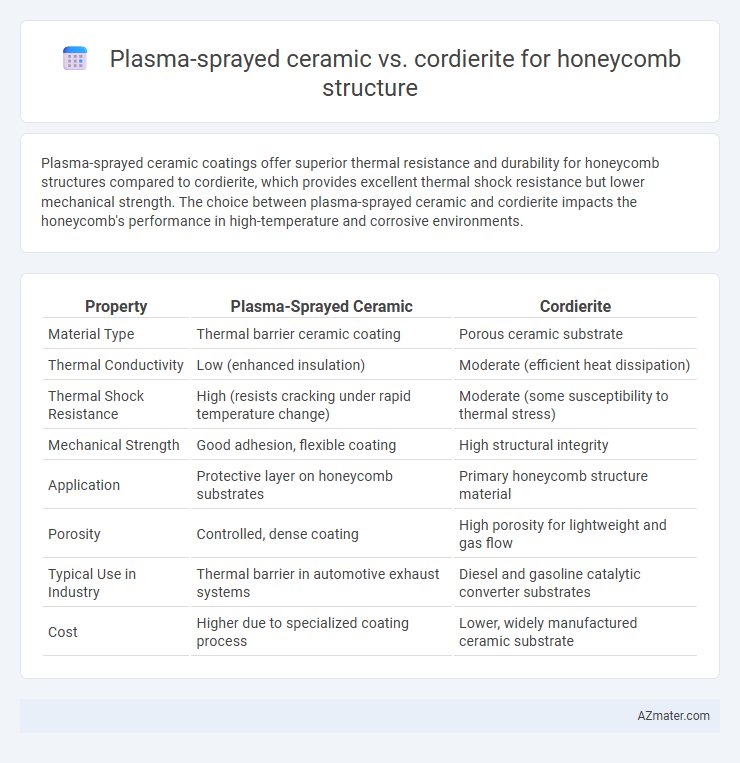Plasma-sprayed ceramic coatings offer superior thermal resistance and durability for honeycomb structures compared to cordierite, which provides excellent thermal shock resistance but lower mechanical strength. The choice between plasma-sprayed ceramic and cordierite impacts the honeycomb's performance in high-temperature and corrosive environments.
Table of Comparison
| Property | Plasma-Sprayed Ceramic | Cordierite |
|---|---|---|
| Material Type | Thermal barrier ceramic coating | Porous ceramic substrate |
| Thermal Conductivity | Low (enhanced insulation) | Moderate (efficient heat dissipation) |
| Thermal Shock Resistance | High (resists cracking under rapid temperature change) | Moderate (some susceptibility to thermal stress) |
| Mechanical Strength | Good adhesion, flexible coating | High structural integrity |
| Application | Protective layer on honeycomb substrates | Primary honeycomb structure material |
| Porosity | Controlled, dense coating | High porosity for lightweight and gas flow |
| Typical Use in Industry | Thermal barrier in automotive exhaust systems | Diesel and gasoline catalytic converter substrates |
| Cost | Higher due to specialized coating process | Lower, widely manufactured ceramic substrate |
Introduction to Honeycomb Structures in Industrial Applications
Honeycomb structures are widely utilized in industrial applications for their exceptional strength-to-weight ratio and thermal insulation properties. Plasma-sprayed ceramic coatings offer enhanced thermal resistance and durability on honeycomb substrates, making them ideal for high-temperature environments such as automotive exhaust systems and aerospace components. Cordierite, known for its low thermal expansion and high thermal shock resistance, remains a preferred ceramic material for honeycomb substrates in catalytic converters and industrial filters.
Overview of Plasma-Sprayed Ceramic Materials
Plasma-sprayed ceramic materials exhibit exceptional thermal stability, wear resistance, and high-temperature durability, making them ideal for honeycomb structures in automotive and industrial catalytic converters. These ceramics, typically composed of alumina, zirconia, or their composites, provide superior corrosion resistance and mechanical strength compared to traditional cordierite substrates. The plasma-spraying process creates a dense, uniform coating that enhances the efficiency and lifespan of catalytic honeycomb filters under extreme operating conditions.
Key Characteristics of Cordierite in Honeycomb Structures
Cordierite honeycomb structures exhibit exceptional thermal shock resistance and low thermal expansion, making them ideal for high-temperature applications such as catalytic converters and diesel particulate filters. Their inherent porosity and chemical stability enhance durability and reduce thermal stress-induced cracking compared to plasma-sprayed ceramic coatings. Cordierite's lightweight nature combined with high mechanical strength supports efficient exhaust gas flow while maintaining long-term structural integrity in harsh environments.
Thermal Resistance: Plasma-Sprayed Ceramics vs Cordierite
Plasma-sprayed ceramic coatings offer superior thermal resistance compared to cordierite in honeycomb structures, withstanding temperatures exceeding 1200degC, while cordierite typically endures up to 1000degC. The dense microstructure of plasma-sprayed ceramics reduces thermal shock and enhances durability under high-temperature cycles. Cordierite's lower thermal conductivity makes it less prone to thermal expansion but limits its application in extreme heat environments where plasma-sprayed ceramics excel.
Mechanical Strength and Durability Comparison
Plasma-sprayed ceramic coatings on honeycomb structures exhibit superior mechanical strength due to their dense microstructure and excellent adhesion properties, enhancing resistance to thermal shock and mechanical wear. Cordierite honeycombs offer good thermal stability and low thermal expansion but generally have lower fracture toughness compared to plasma-sprayed ceramics, limiting their durability under high-stress conditions. The plasma-sprayed ceramic honeycombs demonstrate greater durability in harsh environments, making them preferable for applications requiring high mechanical robustness and prolonged service life.
Chemical Stability and Corrosion Resistance
Plasma-sprayed ceramic coatings exhibit superior chemical stability compared to cordierite, maintaining structural integrity under high-temperature and corrosive gas environments typically found in honeycomb catalytic converters. Cordierite, while cost-effective and thermally stable, is more susceptible to chemical degradation and corrosion when exposed to acidic gases and thermal cycling. The enhanced corrosion resistance of plasma-sprayed ceramics ensures longer service life and reduced catalyst contamination in honeycomb structures used for emission control.
Manufacturing Processes: Plasma Spraying vs Cordierite Forming
Plasma spraying involves depositing molten ceramic particles at high velocity onto substrates, creating dense, adherent coatings ideal for complex honeycomb structures with enhanced thermal barrier properties. Cordierite forming utilizes powder processing techniques like extrusion and sintering to produce honeycomb substrates with low thermal expansion and excellent thermal shock resistance. Plasma spraying offers flexibility and fine microstructural control, whereas cordierite forming provides consistent bulk material properties essential for catalytic converter honeycombs.
Cost Analysis and Economic Considerations
Plasma-sprayed ceramic coatings for honeycomb structures exhibit higher initial material and application costs compared to cordierite, which remains more cost-effective due to its established manufacturing processes and lower raw material expenses. The enhanced thermal resistance and durability of plasma-sprayed ceramics can lead to longer service life and reduced maintenance, potentially offsetting the upfront investment over time. Economic considerations must weigh the total cost of ownership, factoring in operational efficiency, lifespan extension, and replacement frequency between plasma-sprayed ceramics and cordierite-based honeycomb substrates.
Performance in Automotive Catalytic Converters
Plasma-sprayed ceramic coatings on honeycomb structures enhance thermal durability and corrosion resistance, optimizing the performance of automotive catalytic converters by maintaining effective heat management under extreme conditions. Cordierite substrates, known for their low thermal expansion and high mechanical strength, provide structural stability but may exhibit lower resistance to thermal shock compared to plasma-sprayed ceramics. The choice between plasma-sprayed ceramic and cordierite impacts converter efficiency, catalyst adherence, and overall lifespan in demanding automotive environments.
Future Trends and Innovations in Honeycomb Materials
Plasma-sprayed ceramic coatings enhance honeycomb structures with superior thermal resistance and mechanical durability compared to traditional cordierite, enabling applications in extreme environments and advanced automotive catalysts. Emerging trends emphasize nanostructured ceramic layers and hybrid composites to improve crack resistance, thermal shock tolerance, and light-weighting for next-generation catalytic converters and heat exchangers. Innovations in additive manufacturing techniques and tailored microstructures promise greater design flexibility and performance optimization for honeycomb materials in sustainable energy and emission-control technologies.

Infographic: Plasma-sprayed ceramic vs Cordierite for Honeycomb structure
 azmater.com
azmater.com